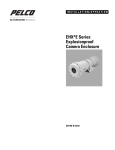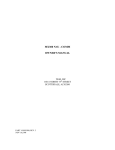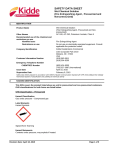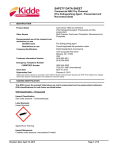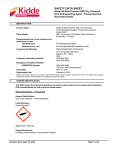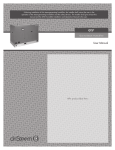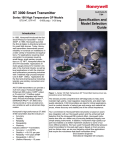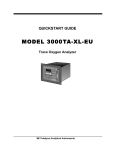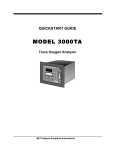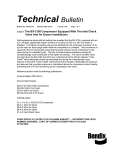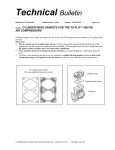Download BENDIX TCH-001-052 User's Manual
Transcript
Technical Bulletin Bulletin No: TCH-001-052 Effective Date: 5/4/04 Subject: Troubleshooting Bendix® inlet check valves on DDC Series 60 low-emission engines in cases where the compressor does not build air. If a DDC Series 60 low emission engine does not build air, as part of the investigation to find the cause, you may use the following test to check that the Inlet Check Valve (ICV) is operating correctly. We recommend that other less labor-intensive inspections, for example, to check for a leaking or broken discharge line, be carried out before conducting this test. Before beginning this test, read the complete instructions, and follow all standard safety practices including, but not limited to, the General Precautions listed below. With the vehicle parked and the wheels blocked, shut off the engine. Clean the area around the ICV of road grime, etc. Disassembly To test the ICV, disconnect the hose that supplies air from the inlet air supply system of the engine to the ICV. Carefully remove the clamp holding the inlet hose from the ICV - see Figure 1 for a typical inlet hose location. Retain the clamp for re-installation. Note that the ICV has a raised flange on the side through which the air enters. This test will necessitate the removal of the ICV from the vehicle, therefore remove the mounting hardware attaching it to the vehicle - in some instances it will be easier to remove the mounting bracket from the engine to assist with the disassembly. Test the ICV Caution: Eye protection equipment must be worn during this procedure to prevent eye injury in the event loose material is expelled from the ICV port. On a test bench securely mount the ICV. Attach a nonpressurized shop air supply line to the delivery side of the ICV using any necessary fittings. Apply shop air to the ICV and, with caution, observe the inlet port of the ICV for air being expelled. A correctly operating ICV will produce only a small amount of air coming (backwards) through the valve. A malfunctioning ICV will release a full burst of air (similar to a blow nozzle). End the test by shutting off the shop air. Cancels: TCH-001-052 of 11/11/03 Page: 1 of 2 Inlet hose attaches here Air flows in this direction through valve ICV Figure 1: Inlet Check Valve (location varies by vehicle) If the ICV is operating normally, reinstall the ICV by reversing the steps taken to remove it from the vehicle. Re-attach the inlet hose using the clamp retained during disassembly, ensuring a good seal between the hose and the fitting. Consult other troubleshooting materials and vehicle manuals to help you investigate why the compressor is not building air. In the case of a malfunctioning ICV, where the compressor does not built air, replace the ICV valve and the compressor because of possibility of debris in the system. GENERAL PRECAUTIONS IMPORTANT! PLEASE READ AND FOLLOW THESE INSTRUCTIONS TO AVOID PERSONAL INJURY OR DEATH: When working on or around a vehicle, the following General Precautions should be observed at all times: 1. Park the vehicle on a level surface, apply the parking brakes, and always block the wheels. 2. Stop the engine when working around the vehicle. 3. Except as directed in these instructions, make certain to drain the air pressure from all reservoirs before beginning any work on the vehicle. (continued over.) © 2004 Bendix Commercial Vehicle Systems LLC. All rights reserved. 4/2004. Printed in U.S.A. Bulletin No: TCH-001-052 Subject: 4. 5. 6. 7. Effective Date: 5/4/04 Cancels: TCH-001-052 of 11/11/03 Page: 2 of 2 Bendix® Inlet Check Valves As needed, following the vehicle manufacturer’s recommended procedures, deactivate the electrical system in a manner that removes all electrical power from the vehicle. Typically, when working in the engine compartment the engine should be shut off. Where circumstances require that the engine be in operation, extreme caution should be used to prevent personal injury resulting from contact with moving, rotating, leaking, heated, or electrically charged components. Never connect or disconnect a hose or line containing pressure; it may whip. Never remove a component or plug unless you are certain all system pressure has been depleted. Never exceed recommended pressures and always wear safety glasses. 8. Do not attempt to install, remove, disassemble or assemble a component until you have read and thoroughly understand the recommended procedures. Use only the proper tools and observe all precautions pertaining to use of those tools. 9. Use only genuine Bendix replacement parts, components, and kits. Replacement hardware, tubing, hose, fittings, etc. should be of equivalent size, type, and strength as original equipment and be designed specifically for such applications and systems. 10. Components with stripped threads or damaged parts should be replaced rather than repaired. Repairs requiring machining or welding should not be attempted unless specifically approved and stated by the vehicle or component manufacturer. 11. Prior to returning the vehicle to service, make certain all components and systems are restored to their proper operating condition. See vehicle manual, Bendix troubleshooting materials, or visit www.bendix.com for more information. © 2004 Bendix Commercial Vehicle Systems LLC. All rights reserved. 5/2004. Printed in U.S.A.


